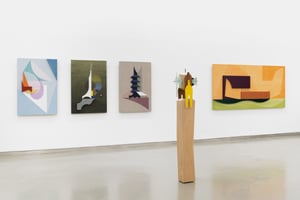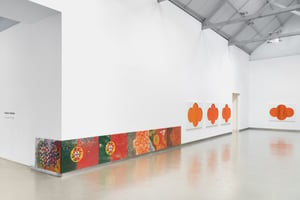GALERIA FILOMENA SOARES - Lisbon
- The exhibition ἀρχιτέκτων (architéktōn), opening at Galeria Filomena Soares in Lisbon, presents a new series of works by Carlos Garaicoa, developed from the formal and conceptual research initiated in π = 3.1416, first shown in Madrid in early 2024. Continuing along this path, the artist revisits painting on wood—a medium he began exploring more consistently in 2019 with the installation Paisajes de trabajo—and deepens his interest in geometry, architecture, and the city as symbolic structures and frameworks for constructing thought. The works now gathered in Lisbon do not represent a full embrace of abstraction, but rather use it as a tool to reflect on the ways we organize space and knowledge. Through rigorous compositions, carefully controlled color planes, and Cartesian volumes, Garaicoa unfolds a visual vocabulary where architectural drawing, geometric art, and formal restraint intersect, alluding to the layered complexity of the contemporary world. The series Arquitectos griegos, also featured in the exhibition, builds a bridge to classical tradition, evoking figures and forms from Ancient Greece as foundational references for the idea of architecture—understood here as both language and system. This trajectory naturally leads to the sculptural series _Cristalografía/Chrystallography_ (2024), which began with the discovery of old Austrian crystallography models (c. 1900), acquired by the artist in an antique shop in Munich. By incorporating these historical objects into sculptures made of wood and glass, Garaicoa creates a tension between scientific rationality and poetic imagination, evoking the duality of structure and fragility, city and nature, design and ruin. These sculptures reveal an intersection between earlier projects—such as _Proyecto frágil_ and _Jardín frágil_ —and a new three-dimensional grammar within his work, in which sculpture emerges as an expanded, unruly territory. At the crossroads of art, architecture, and visual philosophy, Carlos Garaicoa offers a critical and sensitive reading of the urban and cultural world we inhabit, where formal construction—executed with both rigor and delicacy—exposes the fractures and contradictions of modernity.Description
ἀρχιτέκτων (architéktōn) | Carlos Garaicoa
⇾ 13 sep 2025

- Fredrik Værslev’s work explores how painting can evoke familiar imagery—sunsets, flags, curtains, windows—without representing them directly. His polyptych Untitled (Sunset 1) suggests the experience of a sunset through horizontal lines and color transitions, rather than literal depiction. His flag series, focused on the Portuguese flag, reflects on the tension between national symbols and painterly intervention. Initially printed via silkscreen, each flag is altered through color shifts, distortions, or graffiti-like marks, challenging the idea of patriotic unity. These interventions question the symbolic power of flags, especially relevant in times of political tension—such as Trump’s 2024 rally backdrop or the redesign controversy of Portugal’s national logo. The choice to paint only Portuguese flags in a Norwegian context adds irony. Few Norwegians recognize the symbol, while in Portugal the works may provoke nationalist interpretations or discomfort. The repetition and variation of the same image aligns with Værslev’s interest in seriality and the legacy of artists like Jasper Johns and Louise Lawler—where context and presentation shape meaning. The Curtains series references domestic improvisation, where mismatched fabrics serve aesthetic and practical needs. These works, often marked with stains and fluorescent lines, detach curtains from utility to reclaim them as paintings. They evoke personal memory while resisting decorative function. Lastly, Windows—fabric-covered and weathered over Norwegian seasons—evoke architectural mimicry. These are not real windows, but blind, painted facades, referencing colonial and religious architecture. Their opacity recalls Douglas Gordon’s Blind Images, suggesting absence and symbolic blindness. Across Flags, Curtains, and Windows, Værslev destabilizes familiar forms through painting, inviting viewers to reflect on representation, perception, and identity. His works exist in tension between recognition and abstraction, cultural symbol and artistic gesture—joyfully undermining the very things they appear to depict.Description
Fredrik Værslev in Portugal | Fredrik Værslev
⇾ 13 sep 2025
